
Home
Services
About us
Blog
Contacts
Custom Mobile App Development for Smart Wine Cabinets: Unlocking Premium IoT Experiences for Wine Lovers & Businesses
1. Introduction: When Wine Meets Technology
2. Understanding Smart Wine Cabinets: A Market Ready to Innovate
3. Why a Custom App is a Game-Changer
4. Core Features of a Smart Wine Cabinet App
5. Technical Architecture and Development Process
6. Use Cases: From Private Collectors to Restaurant Chains
7. Why Choose A-Bots.com for Your Wine Tech App
8. Conclusion: Elevating the Wine Experience Through Technology

1. Introduction: When Wine Meets Technology
Wine has always been a symbol of sophistication, heritage, and taste. Across centuries, it has brought people together, celebrated milestones, and embodied the craft of preservation and aging. But in the 21st century, even the timeless rituals of wine culture are being transformed by technology. Enter the smart wine cabinet — a fusion of tradition and innovation that is quietly reshaping both the home and commercial wine experience.
Smart wine cabinets — also known as connected wine fridges or digital wine cellars — are climate-controlled appliances enhanced with connectivity, sensors, and sometimes even AI algorithms. They allow users to precisely monitor and control temperature, humidity, and vibration levels, often across multiple storage zones. However, what truly elevates these appliances to “smart” status is their integration with mobile applications.
This is where custom mobile app development enters the picture.
A custom mobile app for a wine cabinet does more than just display temperature. It can turn a simple appliance into a personal wine assistant — allowing users to manage their wine inventory, receive smart recommendations, automate serving preferences, and even pair wines with meals or occasions. For restaurants and wine bars, it enables powerful analytics, inventory tracking, and synchronization with point-of-sale or procurement systems. In both B2C and B2B settings, a tailored app adds real value — operationally, experientially, and financially.
The global market signals that this is more than a trend — it’s a serious opportunity. According to Fact.MR, the smart wine cellar market was valued at $13.84 billion in 2023 and is projected to grow to $31.29 billion by 2033, representing a CAGR of over 8.2%. Much of this growth is fueled by the increasing demand for premium kitchen appliances, the rapid adoption of IoT ecosystems, and the digitization of the luxury hospitality sector.
Yet, despite these developments, the software side often remains underdeveloped. Many existing wine cabinet apps are generic, poorly designed, or offer only basic functions like turning the fridge on and off remotely. Others are clunky, unintuitive, or not even supported across multiple platforms. This gap between hardware and user experience creates a competitive opening for manufacturers, hospitality brands, and luxury retailers: to differentiate their product through a bespoke, beautifully designed mobile app.
This is precisely where A-Bots.com steps in.
At A-Bots.com, we specialize in custom mobile app development for smart devices, particularly in niche markets like connected kitchen appliances. We combine IoT expertise, mobile UX/UI design, and cloud integration to create fully tailored applications that reflect your brand, enhance the user experience, and unlock the full potential of your product.
In this article, we’ll explore the complete landscape of smart wine cabinet app development — from market dynamics and cabinet types to essential features, technical architecture, and real-world use cases. Whether you’re a wine tech startup, a global appliance brand, or a premium restaurant chain, this guide will show you why investing in a custom app is no longer optional — it’s essential for standing out in the modern, connected kitchen market.
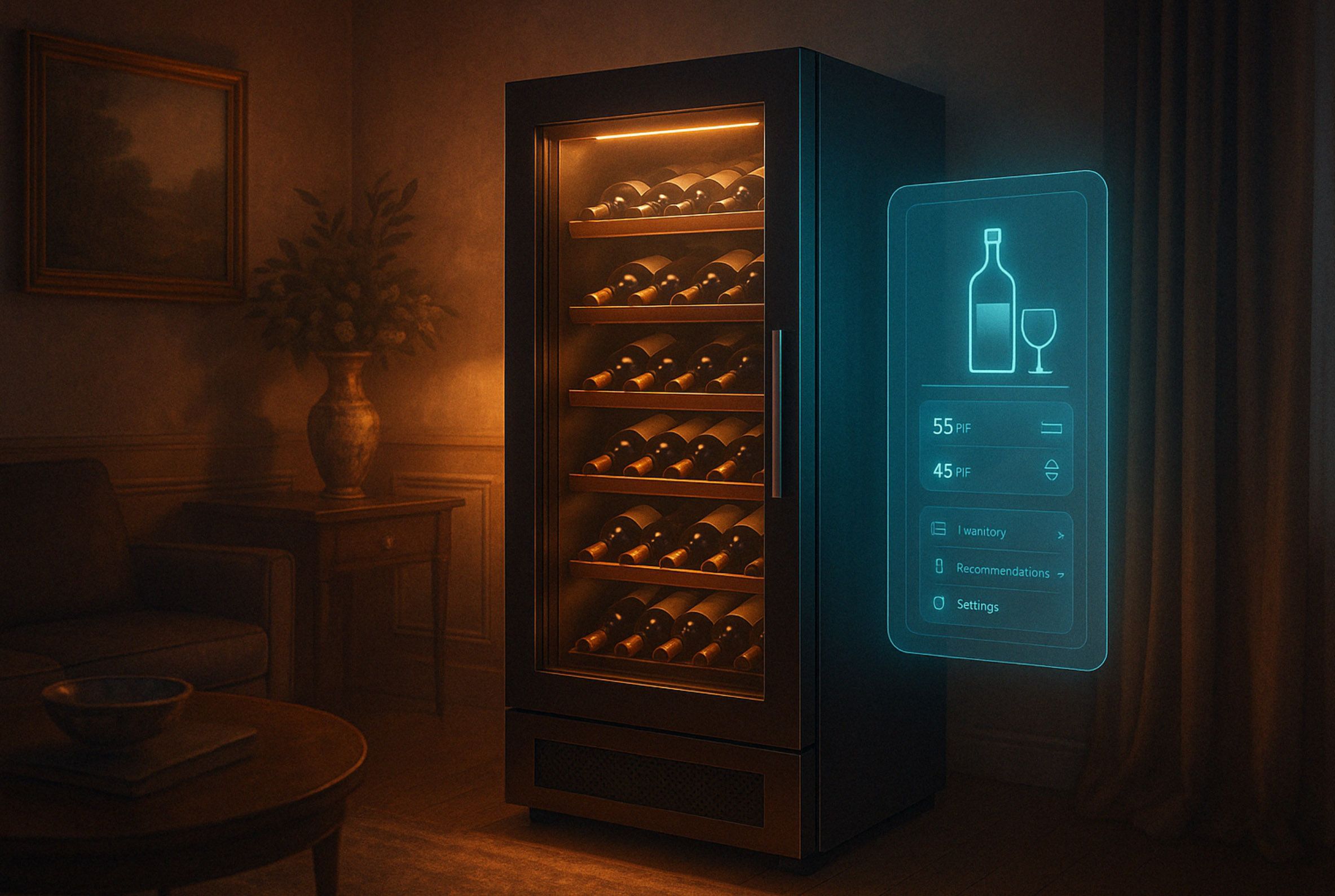
2. Understanding Smart Wine Cabinets: A Market Ready to Innovate
In the evolving landscape of luxury home appliances and hospitality solutions, smart wine cabinets have emerged as a fusion of tradition and cutting-edge technology. These devices not only preserve the integrity of wine collections but also enhance user interaction through advanced features and connectivity.
Types of Smart Wine Cabinets
Understanding the various types of smart wine cabinets is crucial for selecting the right solution tailored to specific needs:
-
By Cooling Technology:
- Compressor-Based Cabinets: Utilize vapor compression systems, offering robust cooling capabilities suitable for larger collections and varying ambient temperatures.
- Thermoelectric Cabinets: Employ solid-state cooling, providing quieter operation and energy efficiency, ideal for smaller collections and stable environments.
-
By Temperature Zones:
- Single-Zone Cabinets: Maintain a uniform temperature throughout, suitable for storing one type of wine.
- Dual-Zone Cabinets: Feature separate compartments with independent temperature controls, accommodating both red and white wines at their optimal conditions.
-
By Installation Type:
- Freestanding Units: Offer flexibility in placement, ideal for standalone use in various settings.
- Built-In Cabinets: Designed to integrate seamlessly into cabinetry, providing a cohesive look in kitchens or bars.
- Integrated Models: Fully concealed behind custom panels, blending indistinguishably with surrounding furniture for a minimalist aesthetic.
Market Growth and Trends
The smart wine cabinet market is experiencing significant growth, driven by increasing consumer interest in premium wine storage solutions and the adoption of smart home technology. According to a report by DataIntelo, the global smart home wine storage cabinets market was valued at approximately USD 1.2 billion in 2023 and is projected to reach around USD 2.5 billion by 2032, reflecting a compound annual growth rate (CAGR) of 8.5% during the forecast period (dataintelo.com).
This growth is attributed to several factors:
- Rising Wine Consumption: An increase in wine consumption globally has led to a higher demand for proper storage solutions.
- Technological Advancements: Integration of IoT and smart technologies in home appliances has made smart wine cabinets more accessible and user-friendly.
- Aesthetic and Functional Appeal: Modern designs that combine functionality with visual appeal have attracted consumers looking for appliances that complement their home decor.
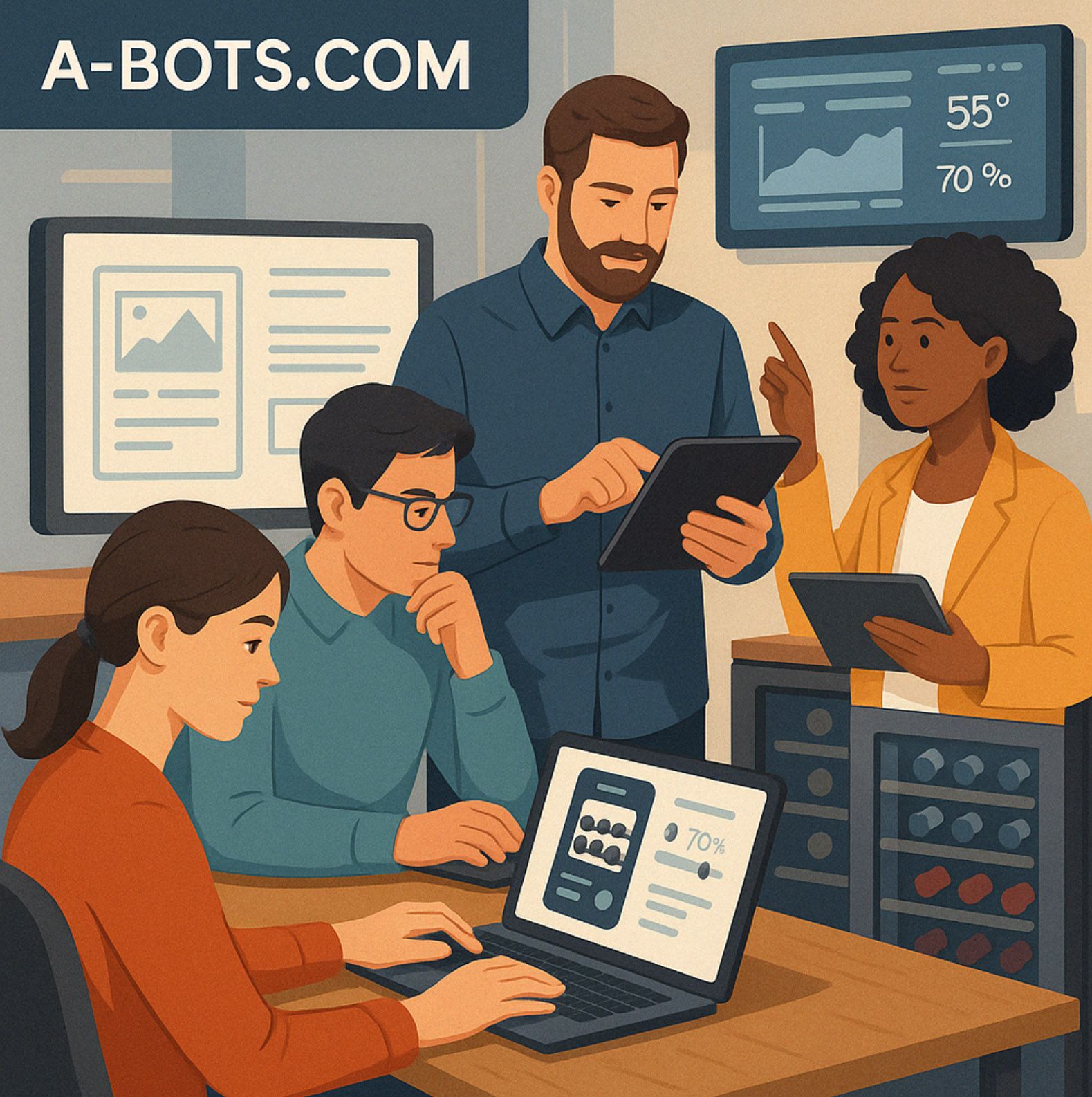
Key Features of Smart Wine Cabinets
Modern smart wine cabinets come equipped with a range of features designed to enhance the wine storage experience:
- Temperature and Humidity Control: Precise regulation ensures optimal storage conditions for different types of wine.
- UV-Resistant Glass Doors: Protect wine from harmful light exposure while allowing visibility.
- Vibration Reduction Systems: Minimize disturbances that can affect wine aging.
- Smart Connectivity: Integration with mobile apps enables remote monitoring and control, inventory management, and personalized settings.
- Customizable Lighting: LED lighting options enhance display aesthetics and user experience.
These features not only preserve the quality of wine but also provide users with convenience and control, aligning with the modern lifestyle's emphasis on smart living.
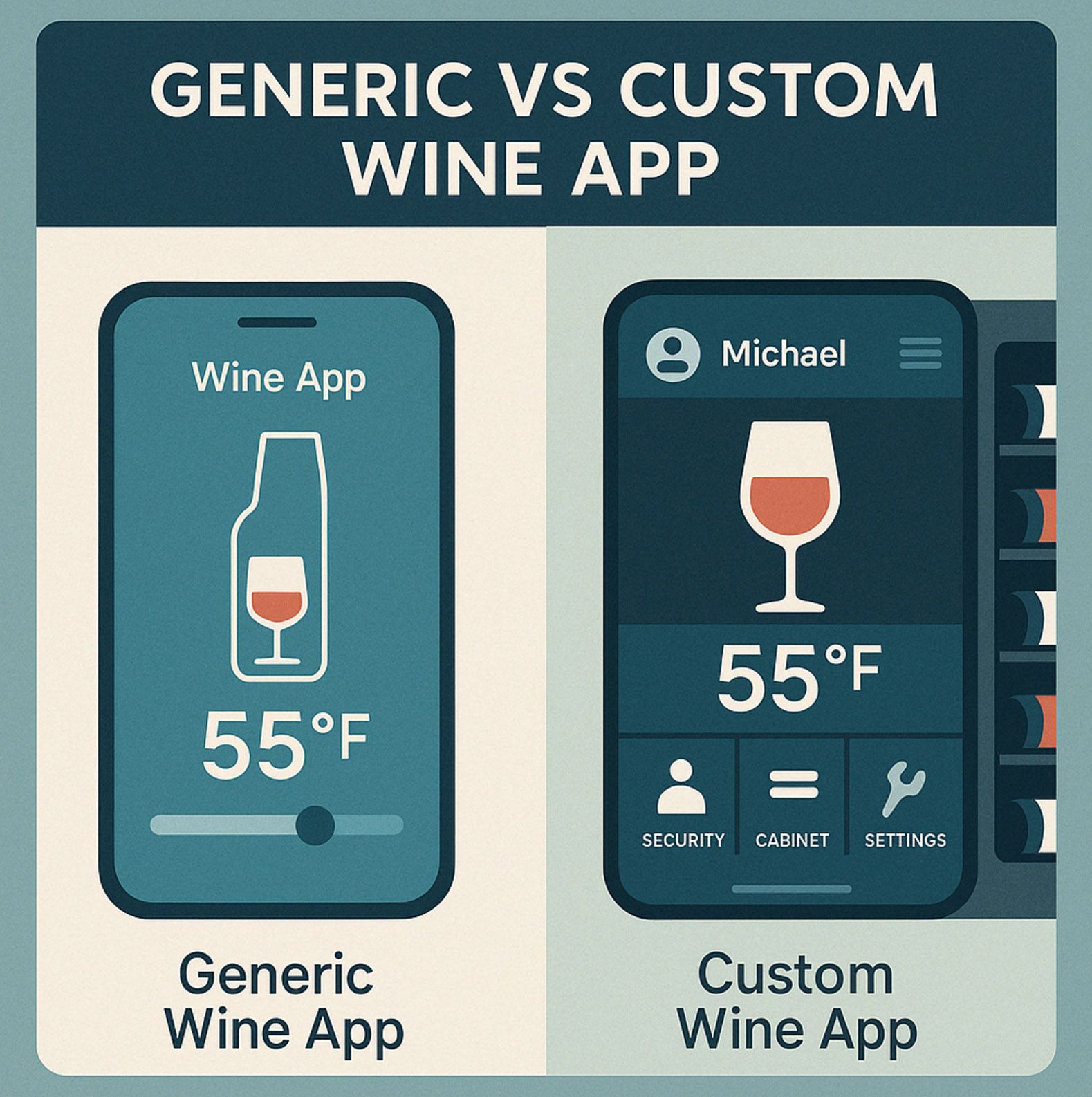
3. Why a Custom App Is a Game-Changer
While smart wine cabinets represent a leap forward in how wine is stored and preserved, the real innovation begins when hardware meets software. The majority of smart wine cabinets on the market today are paired with generic or white-label mobile apps — often limited in scope, poorly designed, or lacking cross-platform consistency. For brands and businesses operating in premium spaces, this presents a major flaw — and an equally major opportunity.
The Problem with Generic Apps
Generic wine fridge apps tend to offer only the basics: turn the unit on/off, adjust the temperature, set humidity. But they fall short in every category that actually defines the modern user experience:
- Lack of Personalization — One-size-fits-all design that ignores brand identity and user preferences
- Poor UI/UX — Cluttered layouts, inconsistent logic, or confusing flows that frustrate rather than delight
- Limited Integrations — No link to inventory systems, POS, or smart assistants
- No Scalability — Impossible to tailor for B2B use cases like restaurants or multi-device management
And for high-end products — where every detail from the brushed steel handle to the ambient LED lighting is designed with care — a poorly executed app becomes a liability.
What a Custom App Can Do Differently
A custom mobile app developed specifically for your smart wine cabinet can redefine how users — whether private collectors or enterprise clients — interact with the product:
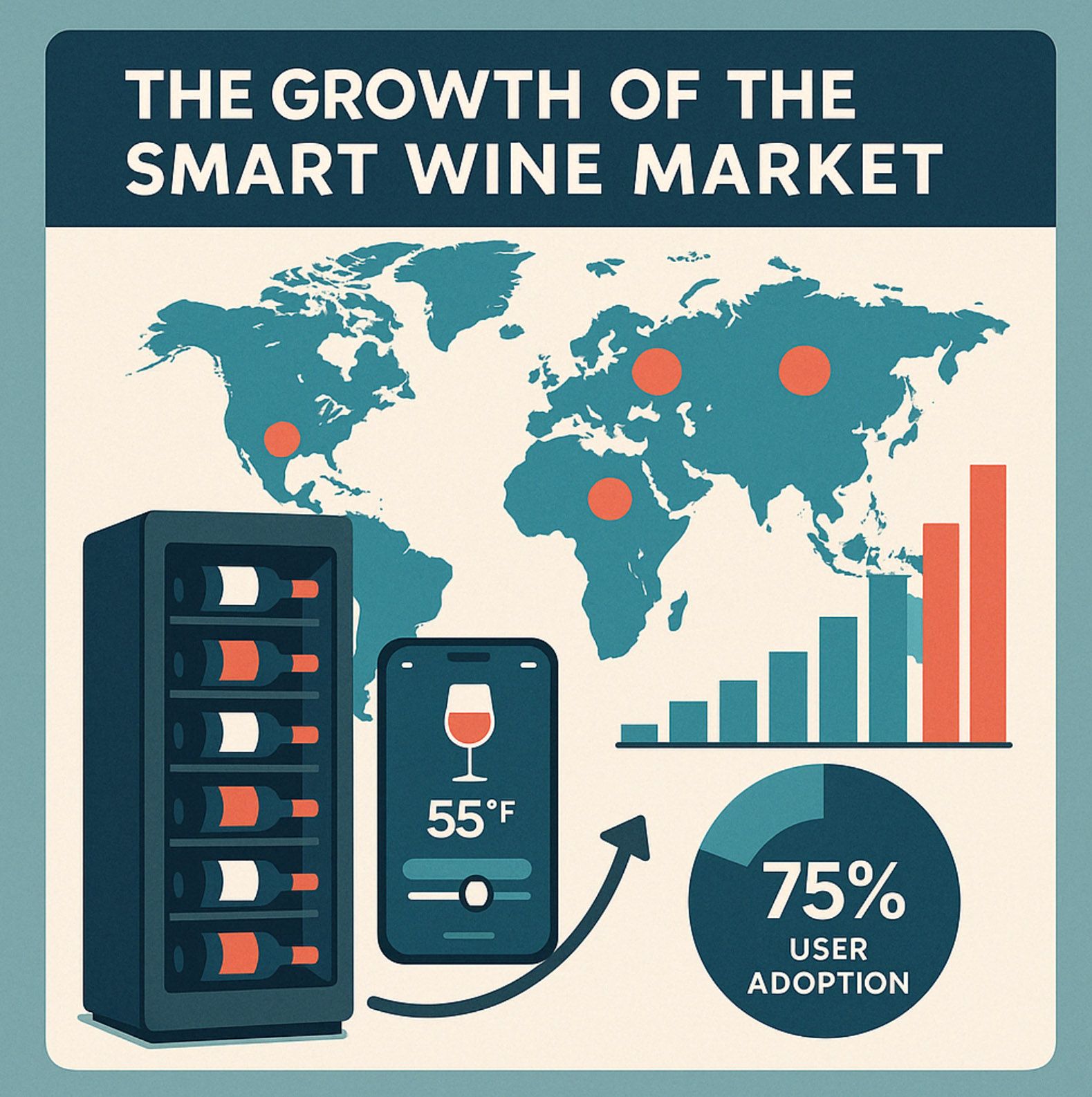
✦ For Private Wine Enthusiasts:
- Inventory Management: Tag, catalog, and track every bottle with AI-powered label scanning or NFC
- Serving Suggestions: AI-based pairing recommendations by varietal, temperature, and food profile
- Cellar Analytics: See how your collection evolves over time — age, consumption trends, optimal drinking windows
- Multi-Zone Control: Set different conditions for red, white, and sparkling wines
- Push Notifications: Get alerts on wine maturity, temperature fluctuations, and restocking needs
- Cloud Sync: Access your collection and settings from multiple devices
✦ For Restaurants, Hotels & Wine Bars:
- Multi-Fridge Control: Manage multiple cabinets across zones or locations from a central dashboard
- Integration with POS & Inventory: Real-time syncing with restaurant systems for ordering and serving
- Team Access: Role-based permissions for sommeliers, bartenders, or procurement managers
- Analytics for Wine Sales & Waste: Optimize stock rotation, reduce loss, and identify top-performing bottles
- Brand-Centric Design: Reflect the look and feel of the venue’s identity and elevate customer interaction
According to a 2023 survey by Wine Business Monthly, over 62% of restaurants are actively looking to digitize their wine storage and inventory processes in the next two years. Custom apps are the key to making this transformation seamless and scalable.
A Strategic Brand Asset, Not Just a Utility
A branded, custom-developed app turns a wine cabinet into a digital lifestyle experience. It becomes:
- A touchpoint for ongoing engagement
- A storytelling platform for wineries, chefs, and sommeliers
- A differentiator in the eyes of luxury buyers and tech-savvy customers
For hardware manufacturers, it’s an opportunity to build a long-term relationship with the user — through app updates, new features, content, and even e-commerce integration.
For hospitality businesses, it’s a way to operationalize wine — managing it like a true asset with data, automation, and control.
And for A-Bots.com, it’s a chance to deliver truly transformational value — not just in code, but in customer experience.
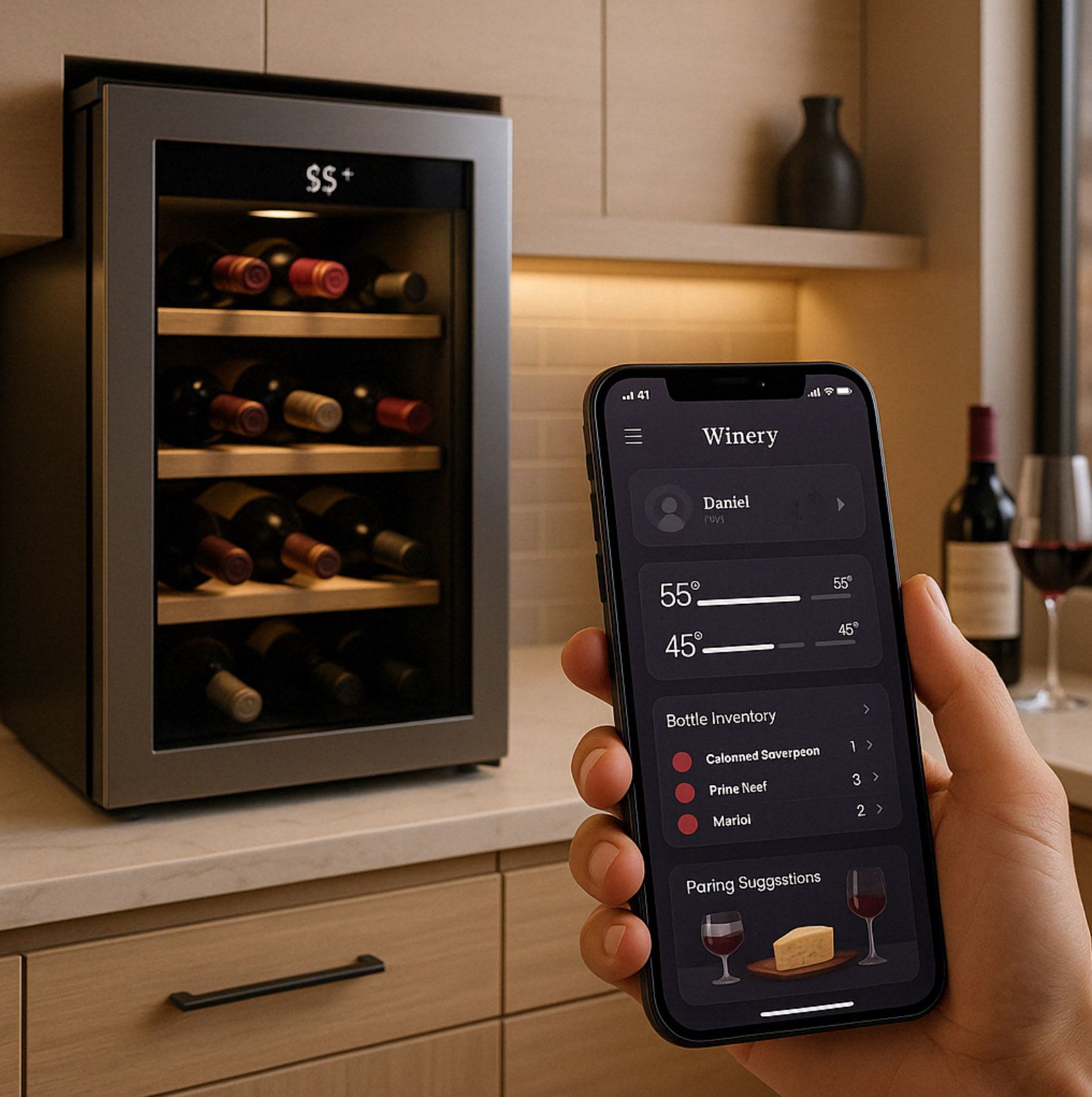
4. Key Features of a Smart Wine Cabinet App
A smart wine cabinet without a thoughtfully designed mobile app is like a wine list without a sommelier — functional, but forgettable. The true elegance of connected wine storage reveals itself through the mobile interface that ties together climate control, inventory management, and user experience. But what should such an app truly offer, beyond simply adjusting the temperature?
The answer lies in the convergence of utility, personalization, and immersion. A premium wine storage app must serve as a seamless extension of both the cabinet’s technical capabilities and the user’s lifestyle. This is not just about controlling the appliance — it's about amplifying the ritual of wine enjoyment through intelligent software.
At its core, the app must offer precise environmental control. This includes adjusting temperature and humidity settings, often for multiple zones within a cabinet — critical when storing both red and white wines under the same roof. Yet a well-designed app doesn’t stop there. It should provide real-time monitoring of these variables, coupled with alerts in case of deviations, power loss, or even door status. These notifications are not mere conveniences — they are safeguards for collections worth thousands, if not tens of thousands of dollars.
More importantly, a custom app introduces personalized interaction. Each bottle can be cataloged digitally, either manually or through technologies like barcode scanning, NFC tags, or even image recognition. Users are no longer just storing wine — they’re curating digital cellars that reflect taste, history, and future plans. The app can suggest ideal serving temperatures, provide information on peak drinking years, and connect to databases of wine reviews or pairing guides. In essence, it evolves from a control panel into a digital sommelier.
In the case of restaurants, wine bars, or luxury hotels, these capabilities take on even greater significance. Staff members may require tiered access, allowing sommeliers to manage selections while inventory teams oversee stock levels. Integration with broader IT infrastructure — including POS systems or inventory management software — transforms the app from a tool into an operational backbone. When a specific wine is opened or served, the system can automatically deduct it from the stock, reducing human error and streamlining procurement.
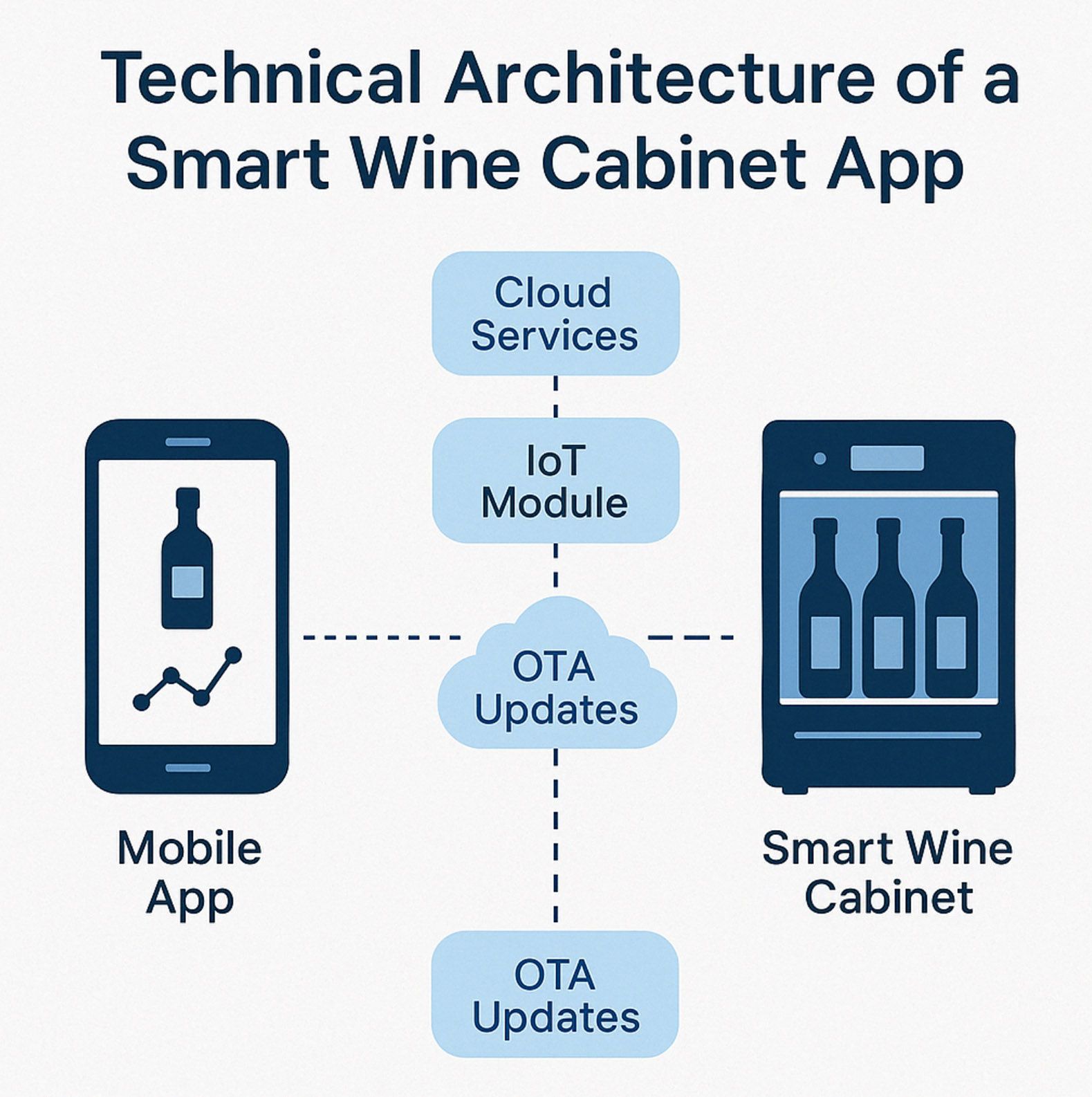
Then there’s the matter of aesthetics and branding. For high-end venues or appliance manufacturers, the app must reflect the same level of craftsmanship as the physical cabinet. Clean typography, intuitive animations, premium visual design — these aren't just superficial add-ons, but crucial indicators of quality in the eyes of discerning users. The app becomes part of the product, not just an accessory.
And finally, an often-overlooked yet vital feature: future readiness. With support for over-the-air (OTA) updates, remote diagnostics, and modular expansion, a custom app future-proofs the smart cabinet, allowing manufacturers or businesses to introduce new capabilities without altering the hardware. This not only extends the product’s lifecycle but also creates ongoing touchpoints with customers — reinforcing brand loyalty and opening opportunities for upselling or service offerings.
In short, the key features of a smart wine cabinet app should not be seen as a checklist of functions. They must form a cohesive, elegant experience that understands and anticipates the needs of its users — whether they’re a collector in a Parisian penthouse or a sommelier managing a 500-label cellar in a five-star resort. And only a custom-built solution can rise to that level of nuance.
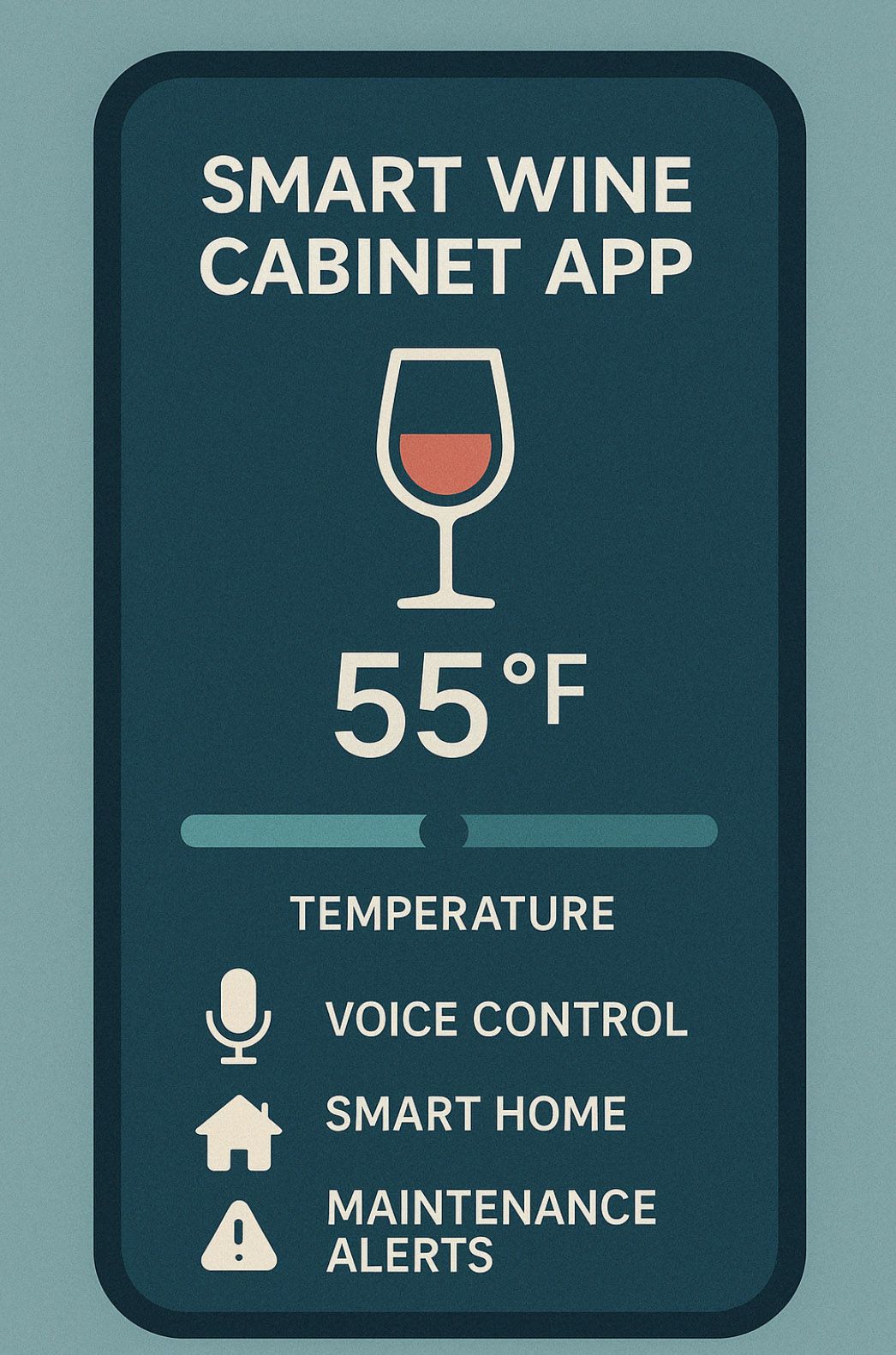
5. Technical Architecture and Development Process
Beneath the elegance of a smart wine cabinet lies a surprisingly complex technological ecosystem — one where software, hardware, and connectivity converge to deliver a seamless user experience. Building a custom mobile app for such a product is not a simple case of UI design or Bluetooth pairing. It is, fundamentally, an exercise in orchestrating multiple systems across physical and digital environments, all while maintaining reliability, security, and scalability.
At the heart of the architecture is the communication layer. Most smart wine cabinets rely on low-energy protocols such as Bluetooth Low Energy (BLE) for close-range device pairing and Wi-Fi for broader remote access and cloud integration. While BLE is ideal for quick pairing and direct device control, Wi-Fi connectivity opens the door to cloud-based services, allowing users to monitor and manage their wine collection from anywhere in the world.
The mobile app itself sits atop this foundation, acting as both a controller and a dashboard. It communicates with the cabinet through a dedicated firmware interface — often via a lightweight protocol such as MQTT or HTTP over TLS — to fetch real-time data and transmit commands. This requires a careful balance between performance and power management, particularly for appliances that must run 24/7 in an energy-efficient manner.
In more advanced implementations, the architecture includes a cloud backend — typically hosted on scalable infrastructure such as AWS or Google Cloud. This backend stores user profiles, wine inventory databases, environmental logs, and settings, while also enabling OTA (over-the-air) updates. OTA is critical not only for feature expansion, but also for bug fixes and compliance updates, ensuring long-term reliability of the entire system.
For enterprise or hospitality use cases, the backend can be extended with APIs that integrate into restaurant inventory systems, POS software, or even customer loyalty platforms. This creates a truly connected ecosystem where wine management is embedded within a broader digital operation — tracking not just what’s inside the cabinet, but how it’s served, sold, and restocked.
On the app side, A-Bots.com typically develops cross-platform solutions using Flutter or React Native for maximum reach across iOS and Android with a single codebase. However, for hardware manufacturers or premium appliance brands that demand pixel-perfect native experiences and low-latency performance, native development in Swift (iOS) and Kotlin (Android) remains a strong option.
Security, of course, is non-negotiable. End-to-end encryption, secure device pairing, GDPR-compliant user data handling, and authentication layers are implemented from day one. Especially in B2B environments — where multiple users may access a single device — role-based access control (RBAC) and audit logging become essential.
The development process itself follows an agile methodology, where we begin with hardware analysis and prototyping, move through iterative design sprints, and conduct deep integration testing with physical cabinet units. Unlike typical mobile apps, those for IoT appliances must account for real-world behaviors — latency in Wi-Fi environments, interference, signal drops, sensor inconsistencies — and these are best resolved through hands-on testing, not simulations alone.
Ultimately, the goal is not just to build an app that connects to a cabinet. It’s to build a resilient, adaptive platform that supports future updates, enables delightful UX, protects user data, and seamlessly integrates into both personal lifestyles and business operations. And that’s where technical excellence makes all the difference.
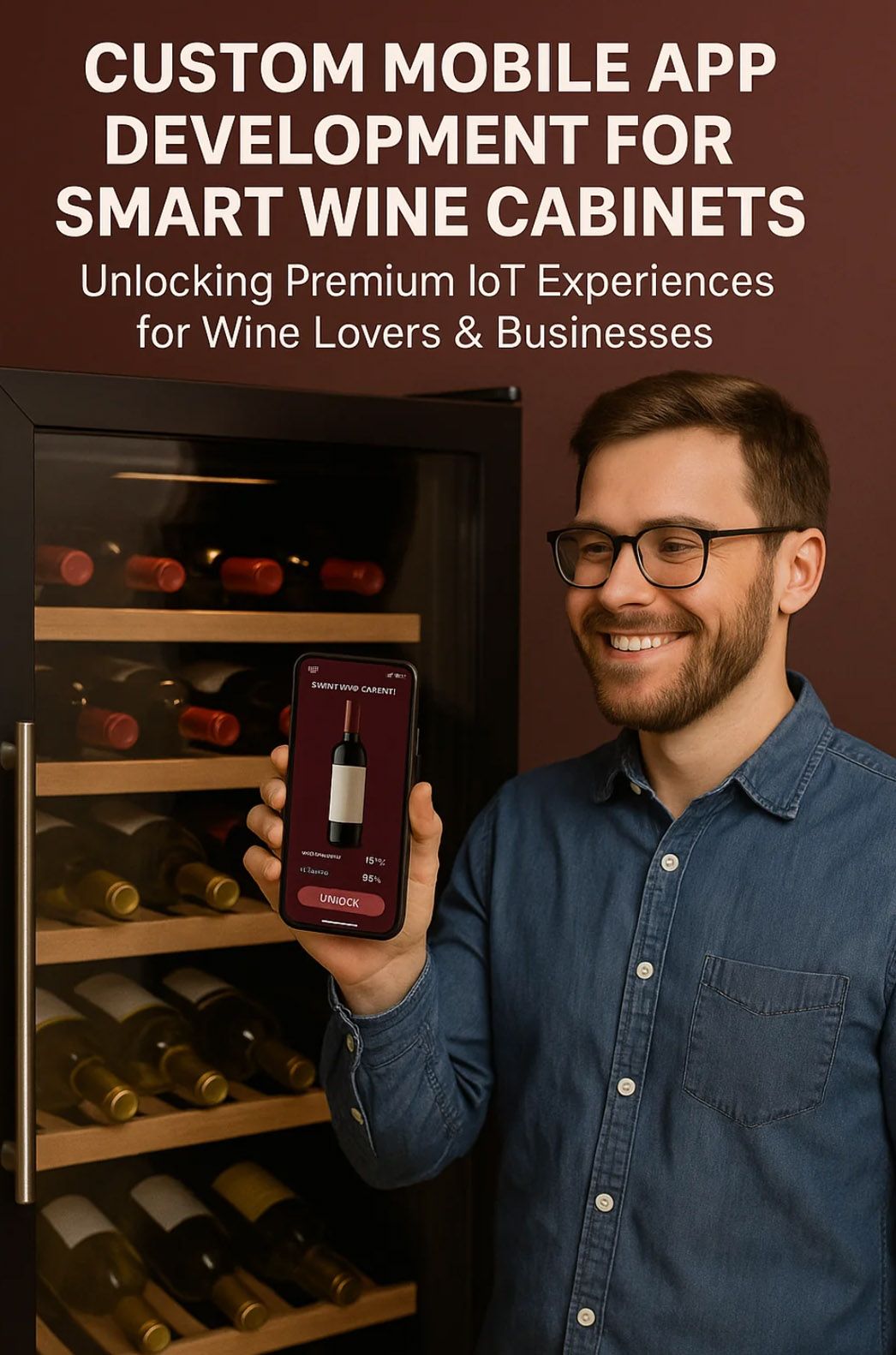
6. Use Cases: From Private Collectors to Restaurant Chains
The versatility of smart wine cabinets, when paired with custom mobile applications, caters to a diverse range of users—from individual enthusiasts to large-scale hospitality businesses. Understanding these varied use cases highlights the transformative impact of tailored digital solutions in the wine storage industry.
Private Collectors: Enhancing Personal Wine Experiences
For individual wine aficionados, a smart wine cabinet offers more than just storage—it becomes a personal sommelier. Through a custom mobile app, collectors can:
- Monitor and adjust storage conditions remotely, ensuring optimal aging.
- Catalog their collection with detailed notes, including vintage, region, and tasting experiences.
- Receive notifications for ideal consumption windows, preserving the wine's peak quality.
Such features not only protect the investment but also deepen the collector's engagement with their collection.
Restaurants and Wine Bars: Streamlining Operations and Elevating Service
In the hospitality sector, efficiency and customer satisfaction are paramount. Smart wine cabinets integrated with custom apps provide:
- Real-time inventory management, reducing the risk of stockouts or overstocking.
- Data analytics to track popular selections, informing purchasing decisions.
- Integration with POS systems, ensuring seamless order processing.
According to a survey by Toast, over 50% of restaurant operators utilize inventory management software to optimize their operations, highlighting the industry's shift towards digital solutions (LLCBuddy).
Hotels and Resorts: Offering Premium Guest Experiences
For luxury accommodations, offering a curated wine experience can distinguish their brand. Smart wine cabinets, controlled via custom apps, allow:
- Guests to personalize their in-room wine selection, enhancing satisfaction.
- Staff to monitor and replenish offerings efficiently, maintaining high service standards.
- Integration with guest profiles, enabling tailored recommendations based on preferences.
This level of personalization not only enhances the guest experience but also fosters brand loyalty.
Wineries and Retailers: Bridging Production and Consumer Engagement
Wineries and wine retailers can leverage smart wine cabinets to:
- Showcase their products in optimal conditions, preserving quality.
- Gather consumer data through app interactions, informing marketing strategies.
- Offer interactive experiences, such as virtual tastings or educational content, directly through the app.
The global winery management software market, valued at USD 12.6 billion in 2024, is projected to reach USD 32.2 billion by 2037, reflecting the growing importance of digital tools in the wine industry (researchnester.com).
These diverse applications underscore the transformative potential of integrating smart wine cabinets with custom mobile applications. By addressing the specific needs of each user segment, businesses can enhance experiences, streamline operations, and drive growth in an increasingly digital marketplace.
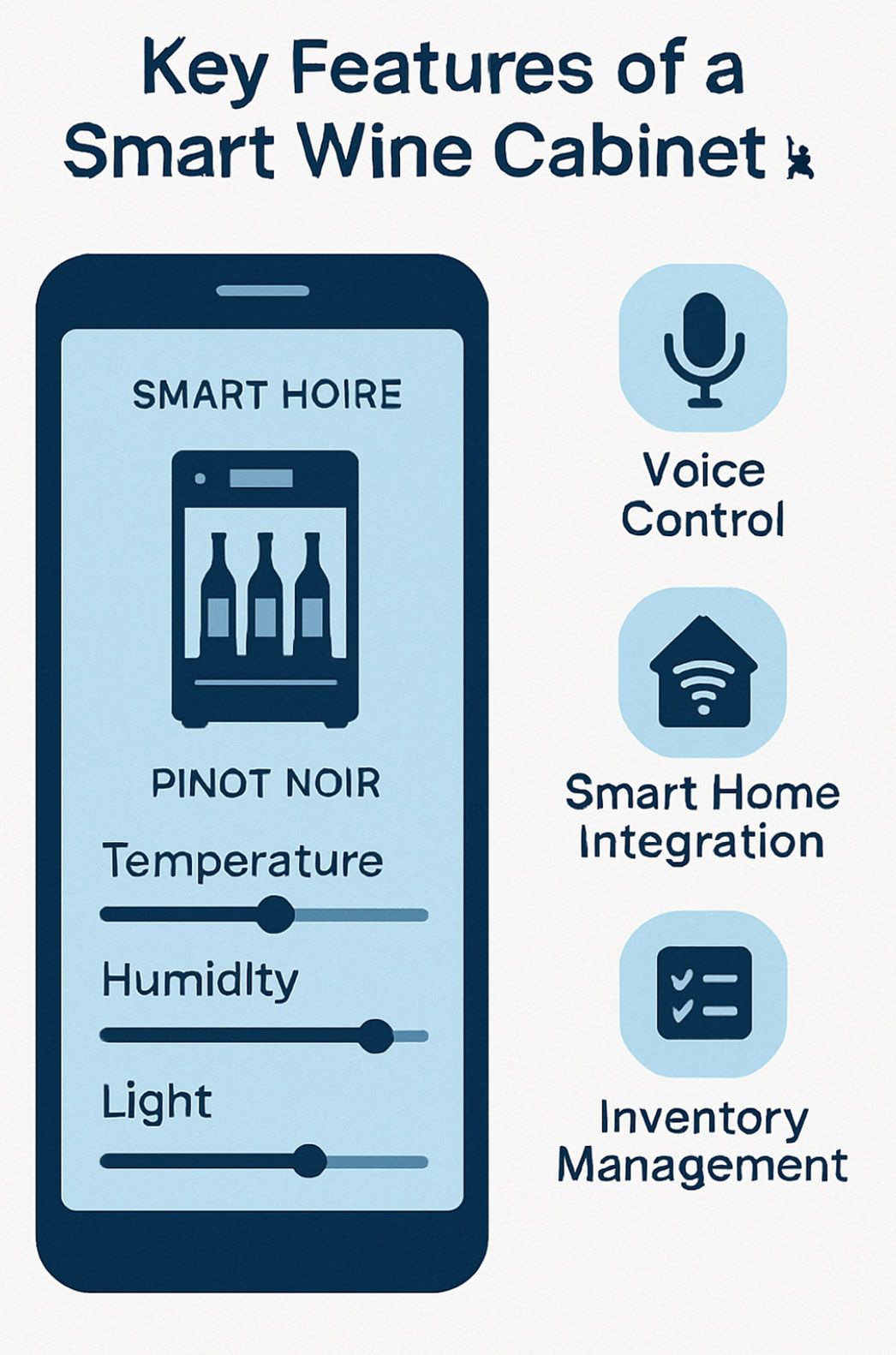
7. Why Choose A-Bots.com for Your Wine Tech App
The decision to build a mobile app for a smart wine cabinet is not simply a question of functionality — it’s a strategic investment in brand identity, customer experience, and long-term competitiveness. In such a niche yet growing segment, partnering with the right development team can define the success or failure of your digital ecosystem.
What makes A-Bots.com uniquely positioned in this space is our deep-rooted specialization at the intersection of IoT, mobile UX, and smart appliance integration. We're not a general-purpose agency that occasionally builds apps for connected devices. We focus specifically on mobile software that bridges the physical and digital — and wine technology is a perfect manifestation of that mission.
When we approach a wine tech project, we begin by immersing ourselves in the real context: the materials, the interfaces on the physical cabinet, the expectations of the end user, and the lifecycle of a bottle from delivery to consumption. We don’t just write code — we map experiences. Whether it’s a private collector managing a hundred vintages or a restaurant overseeing ten smart fridges across three locations, the same design philosophy applies: clarity, elegance, and absolute control.
From a technical standpoint, our team has executed dozens of projects that involve low-energy protocols (like BLE), secure cloud integration, and seamless communication between firmware and app layers. But what sets us apart isn’t just technical fluency — it’s the ability to translate complex hardware behaviors into simple, beautiful, and intuitive mobile interfaces. That’s where the magic happens.
More than that, A-Bots.com is structured to support iterative evolution. We don’t deliver one-time builds and walk away. We collaborate long-term — adding new features, implementing OTA update capabilities, and integrating analytics tools that allow you to monitor how users interact with their wine storage experience. For commercial clients, we bring the added benefit of building apps that are enterprise-ready — with role-based access, team management tools, API interoperability, and support for multi-location environments.
Our designers think like luxury brand consultants. Our engineers code like systems architects. And our product team knows how to ask the right questions — not just “what do you want it to do,” but “how can this app make your product unforgettable?”
Choosing A-Bots.com means choosing a partner who understands that a smart wine cabinet app is not just software. It’s the soul of the experience. It’s how you differentiate in a market of look-alike appliances. It’s how you stay connected to your customer long after the cabinet is installed in their kitchen, restaurant, or hotel suite. A-Bots.com offer mobile app developing for wine cabinets.
And it’s how your brand goes from functional to phenomenal.
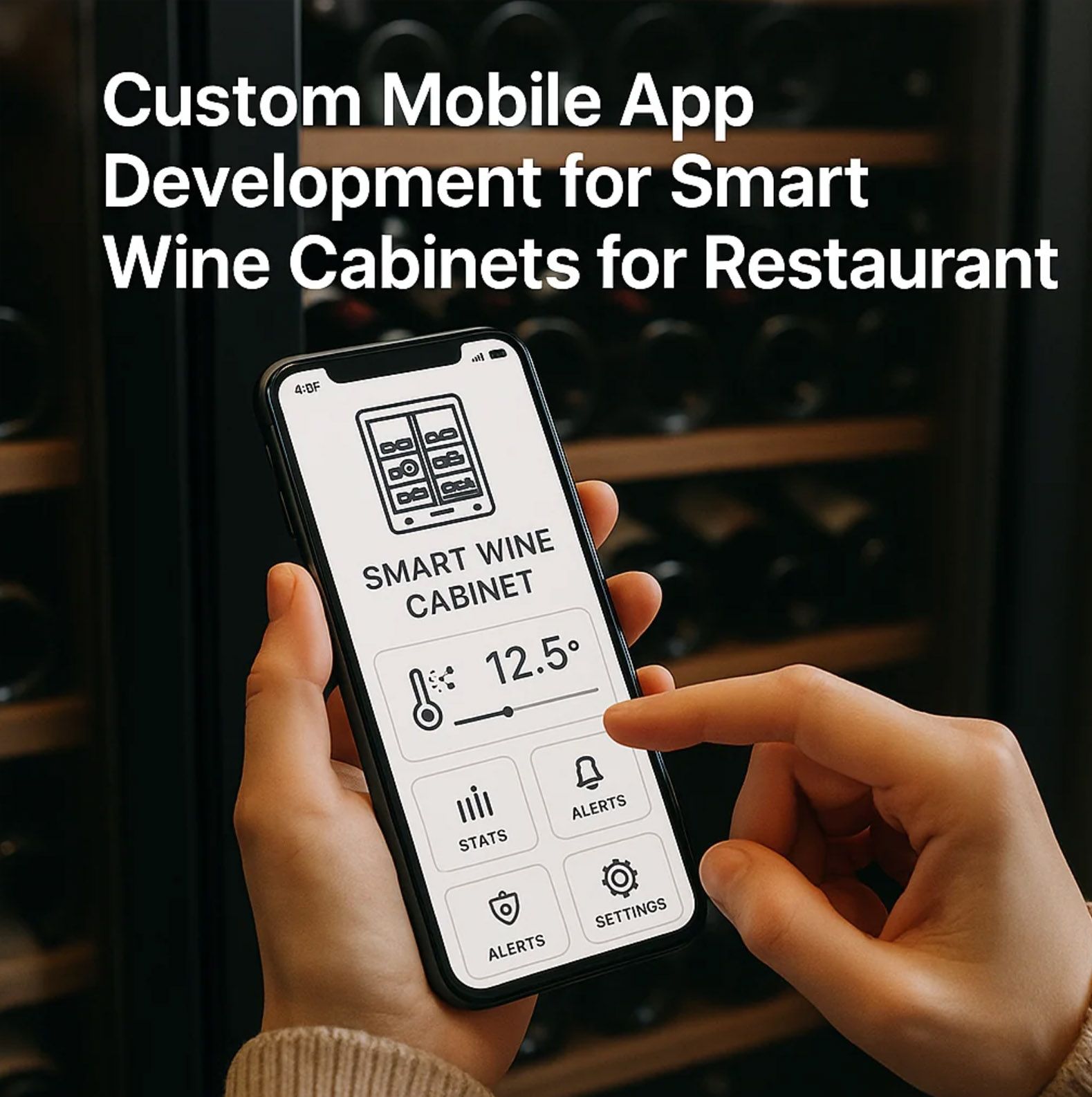
8. Conclusion: The Future Is Aged to Perfection
There was a time when a wine cabinet was just that — a box that kept bottles cold. Today, it can be a gateway to storytelling, personalization, and intelligent living. We live in a world where even our homes reflect our values, our taste, and our technological fluency. In that world, a wine cabinet that does nothing but chill misses the opportunity to connect — literally and emotionally — with its owner.
Smart wine storage is no longer about the hardware. It’s about the experience around the wine: how it’s discovered, tracked, presented, paired, shared. And all of that happens through the app. The mobile app is the interface of intimacy between user and collection. It’s what turns a steel appliance into a living part of the user’s lifestyle. It is the voice of your brand, whispering through elegant design and intelligent logic.
As AI, IoT, and mobile UX continue to evolve, so too will expectations. A static app will grow obsolete. A generic interface will be ignored. But a custom, evolving, brand-powered experience — that’s what will define the next decade of smart kitchen ecosystems.
Here’s the truth: the wine market is not saturated with tech. It’s waiting for tech. And not clumsy add-ons or reskinned off-the-shelf templates, but crafted experiences that reflect the elegance and precision of the product they represent. This is your chance to be among the first — to lead, to stand out, and to redefine what “smart” means in the wine space.
If you are a hardware manufacturer looking to give your appliance a soul…
If you are a luxury hospitality brand seeking to elevate every room, every detail…
If you are a founder dreaming of a wine-tech product that redefines the ritual —
Let’s build it together.
A-Bots.com brings together technologists, designers, and storytellers who understand the sacred nature of experience design — and the commercial value of being unforgettable.
Let’s create something the world has never seen —
A digital experience aged to perfection.
“A-Bots.com — We Build What Your Wine Deserves.”
Hashtags
#SmartWineCabinet
#WineTech
#IoTApps
#CustomAppDevelopment
#SmartKitchen
#WineApp
#WineAppForAndroid
#customwinefridgeapp
#smartwinecabinetapp
#mobileappforwinecellar
#IoTwinestoragesolution
#wineinventoryappforrestaurants
Other articles
Custom CRM for Real Estate Developers
Off-the-shelf CRM tools weren’t built for the complexity of real estate development — but we were. This in-depth article explores why custom CRM solutions are redefining how developers manage projects, leads, teams, and revenue. See real-world ROI calculations, key challenges, and expert insights from A-Bots.com, a top CRM development company.
Custom Agriculture App Development for Farmers In 2024, U.S. farmers are more connected than ever — with 82% using smartphones and 85% having internet access. This article explores how mobile applications are transforming everyday operations, from drone-guided field scouting to livestock health tracking and predictive equipment maintenance. It examines why off-the-shelf apps often fail to address specific farm needs and how collaborative, farmer-funded app development is gaining momentum. Through real-world examples and step-by-step guidance, readers will learn how communities of growers can fund, design, and launch custom apps that fit their exact workflows. A-Bots.com offers tailored development services that support both solo farmers and agricultural groups. With offline capabilities, modular design, and support for U.S. and international compliance, these apps grow alongside the farm. Whether you're planting soybeans in Iowa, raising cattle in Texas, or running a greenhouse in California — this article offers the tools and inspiration to build your own farm technology. Discover why more farmers are saying: we don’t wait for the future — we build it.
Custom Drone Mapping Software & Control Apps: Smarter Aerial Solutions by A-Bots.com Custom drone software is revolutionizing how industries operate—from precision agriculture to infrastructure inspection. This article explores why off-the-shelf apps fall short, how AI and modular design shape the future, and how A-Bots.com delivers tailored drone solutions that truly fit. Whether you manage crops, assets, or entire projects, the right software lifts your mission higher.
Custom IoT for Smart Greenhouses and Vertical Farms Modern greenhouses and vertical farms demand more than off-the-shelf solutions. In this article, discover how custom IoT systems — built around your space, your crops, and your team — can unlock new levels of efficiency, automation, and yield. Packed with real-world examples, insights from A-Bots.com engineers, and expert advice, this guide will inspire your next step in smart agriculture. If you're ready to grow smarter — start here.
Custom Coffee Machine App Development Smart coffee is no longer just about flavor — it's about experience. Discover how custom mobile apps for coffee machines unlock new revenue streams, elevate user engagement, and enhance brand loyalty. Backed by real IoT projects, A-Bots.com delivers world-class app solutions that blend tech with taste. Brew the future with us.
Top stories
Copyright © Alpha Systems LTD All rights reserved.
Made with ❤️ by A-BOTS
